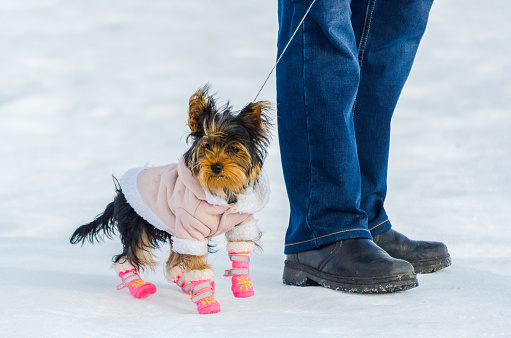A vet has explained why there is ‘no real need’ for dogs to wear boots (Picture: Getty Images/iStockphoto)
A vet has shared a major warning against putting dogs in shoes, even when the temperature drops to freezing lows in the next few days.
In case you haven’t heard, London is set to be covered in snow this week as the weather across the UK takes a chilly turn.
Although dog walkers may feel tempted to put shoes on their dogs to keep their paws warm, vet Dr Anna Foreman has shared her advice about how to keep your dog warm without boots, which she deems unnecessary.
‘As long as owners wash and dry their dog’s paws thoroughly after a walk, there is no real need for outdoor boots,’ she said.
‘These boots are prone to causing a dog distress (dogs are not used to wearing shoes like we are), are easily lost, and are unnecessary in most cases.’
Anna also said that dog’s paws have ‘shoes already’ in the form of their pads.
‘These hard, leathery “soles” prevent injury to the softer skin surrounding and delicate structures underneath,’ she added.
‘They can be cut or penetrated with sharp objects, and so if a dog becomes suddenly lame, their pads should be checked thoroughly as well as the rest of their leg.
There are certain conditions in which Anna would suggest a dog could wear boots in snowy weather.
Boots might be cute but they’re ‘not needed’ according to the vet (Picture: Getty Images/iStockphoto)
‘If a dog is slipping in the wet, ice or snow, their pads are becoming chapped and sore, or the skin of their feet (or the dogs themselves!) are not tolerating being washed, boots can be considered.’
But there is one item Anna, who’s Everypaw Pet Insurance’s in-house vet, swears by when it’s cold. The vet says that raincoats are appropriate for the pooches who don’t have an ‘innately waterproof coat’.
She suggests: ‘The easiest way to find out is by exposing your dog to the rain (or a shower at home!) and then feeling under their fur to the skin underneath
‘If their deeper fur and skin is dry and warm, their outer hair coat is keeping them dry. If the deeper fur and skin is wet or cold then this means an external waterproof coat may be more appropriate to keep them dry.’
To keep your dog safe and comfortable during a walk, it’s important that they aren’t too hot or too cold.
Some canines have innately warm and waterproof coats and piling on the layers could make them feel uncomfortable.
Dog owners should invest in a high visibility collar, lead, accessory, harness or coat to make your dog stand out in conditions with low visibility.
How to keep your dog safe in snowy weather
Wrap up warm – grab a waterproof coat just for your dog to make sure they’re not shivering when they’re outside. This is especially important if your dog is elderly or has a short coat, like greyhounds and staffies.
Check your dog’s paws – salt and grit on the roads could get stuck in your dogs paws, causing irritation and pain. Have a proper check of your dog’s paws when they return inside, and give them a good dry with a towel to remove salt, grit and snow.
Make sure they have a warm and cosy bed – dogs also need a warm and toasty spot to run to after having fun in the snow, just like us. Make sure they have a bed away from draughty areas.
Do some indoor exercise – you may need to shorten your usual daily walk to make sure your dog doesn’t get too cold or tired (and save yourself, too). Make sure they remain active with plenty of toys and puzzles indoors to prevent boredom.
Avoid rivers and lakes – an iced over body of water is far too tempting for most dogs, who’ll want to slide around. You don’t know how stable that ice may be. It could shatter, leaving your dog in danger.
Never leave your dog in a car unattended – the same rule applies all year round. In the winter, a car’s interior can get very chilly.
Know the signs of frostbite in dogs – signs of frostbite in dogs include very pale skin with a blue tint, skin that feels very cold or brittle to touch, blisters, and sore, red areas.
If you notice any symptoms, don’t blast your dog with a hair dryer or stick them next to a radiator. Instead, warm a towel in your clothes dryer or on a radiator, then gently apply the towel to the affected areas. Go to the vet if the areas go darker.
The freezing cold weather is because of an Arctic blast smashing into the nation and dragging temperatures in some areas today as low as -15°C.
Multiple snow and ice warnings are in place until the end of this week – including large swathes of Scotland, which saw 15cm of snow in Aberdeen last night.
Do you have a story to share?
Get in touch by emailing [email protected].
MORE : Weather map shows when and where ‘wall of snow’ will strike UK this week
MORE : Cold Weather Payments have been triggered – here’s how to claim the money
MORE : How to keep your dog safe in the snow
It’s time to put the boots down.


